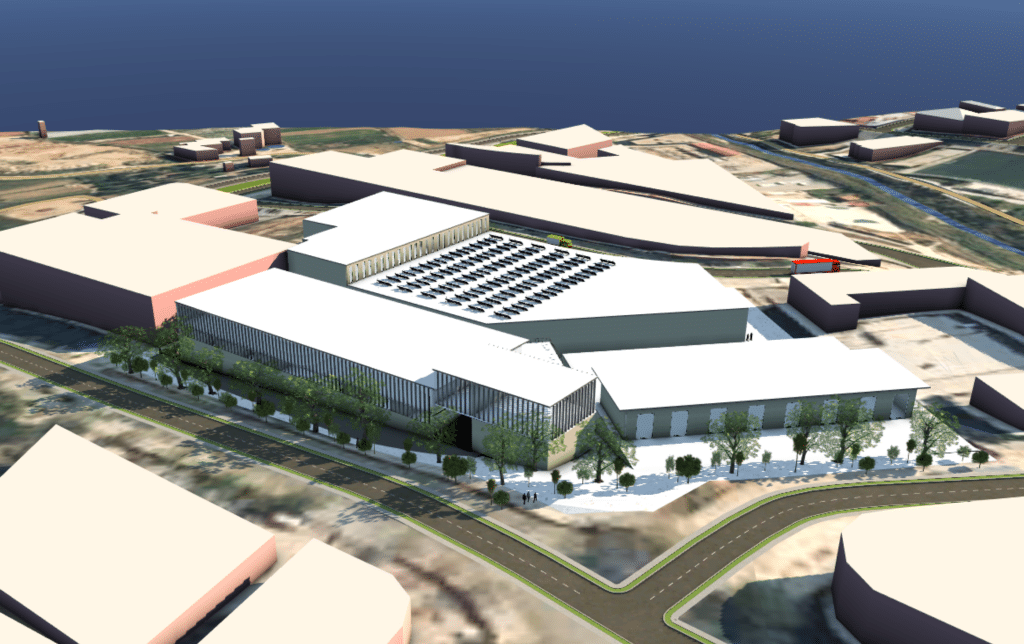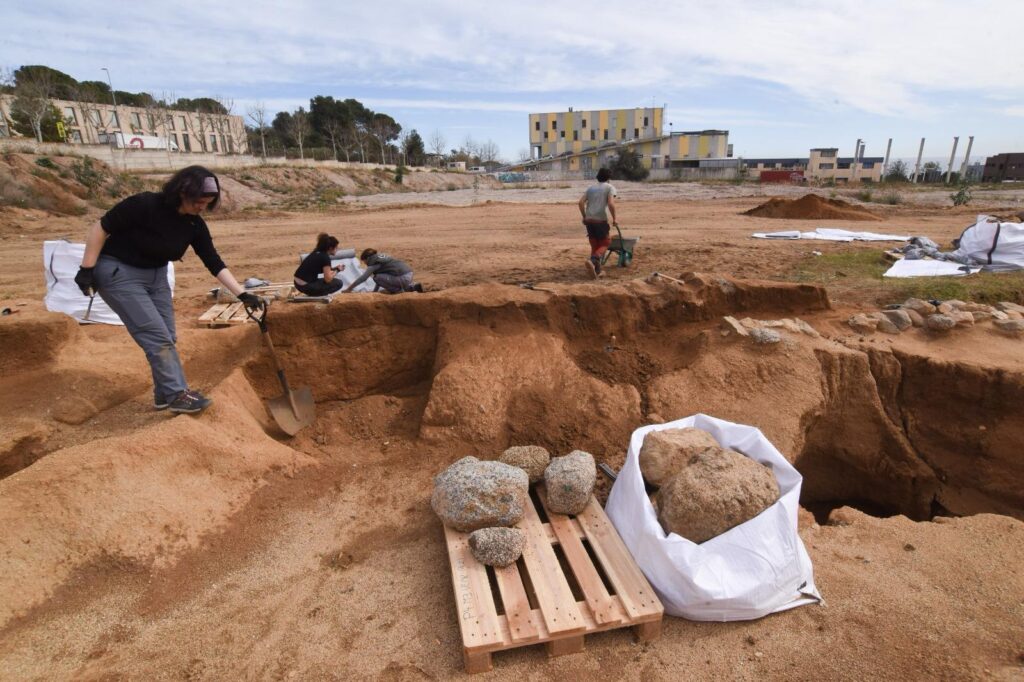The company Baula Recerca Arqueològica SL has begun work to dismantle and move the archaeological finds from the Ca la Madrona site for their preservation.
The finds have been exhaustively documented during the archaeological intervention in preparation for their dismantling and storage. They will be temporarily stored in the same area and will later be definitively moved to make them accessible to the public in the Bon Recés area, 250 metres away.
The transfer of the finds, which has the authorisation of the Department of Culture of the Generalitat de Catalunya, will allow progress to be made in the works of the first phase of the Mataró-Maresme Circular Park, a unique public infrastructure project in Europe of high environmental, economic and social value whose aim is to change the current model of production and consumption towards the circular economy model.
Moreover, this week, the company Can Mansana SL has begun specialised archaeological work on the industrial phase of the plot. These archaeological works will serve to inventory and record the findings that may result from the manual excavation of the site.
The findings documented so far
The remains found in the course of the various archaeological interventions can be divided into three different periods.
From the Roman period (1st-4th centuries), a building built around 70 AD and extensively renovated at the end of the 3rd century or beginning of the 4th century has been documented, and is configured as a building with five different areas that would correspond to rooms in the rustic part of a villa or an isolated establishment for agricultural or industrial purposes, which lasted until the first half of the 5th century. Two turcularium, i.e. two cellars for making wine, have also been found from this period.
From the Late Roman period (built in the first half of the 5th century and used between the end of the same century and the beginning of the 6th century), a street has been found, defined by a large building that preserves an entrance door and a parallel wall. A necropolis has been documented on both sides of the street, from which 88 tombs have been excavated. Studies indicate that the building was an open-air construction without a roof. In Catalonia, very similar buildings have been found in the Monastery of Santa Caterina and in the Monastery of Sant Cugat with a surrounding necropolis; therefore, current hypotheses lead us to believe that this building is a funerary hall.
Finally, from the 14th century, a good number of ditches have been documented for planting vines arranged in rows, walled-off with a bench-like structure.
The state of conservation of the remains is quite poor, as it is a site that has been badly damaged by the industrial past of the plot. Thus, given that the interest of the remains is not in the relevance of the preserved structures, but in the knowledge they provide, and in order to make their conservation compatible with the construction of the Mataró-Maresme Circular Park, the findings will be transferred for their future dissemination in an interpretation centre.
In order for the future museum remains to explain the diachrony of the site and the different agricultural, religious and funerary uses it had, the following structures will be relocated: the presumed funerary hall, part of the late-antique tombs and the remains of the building that would correspond to the rooms of the rustic part of a Roman villa.
Mataró City Council’s proposal is to locate this facility in the Bon Recés area, that is, 250 metres from the original site of the finds. A new urban park will be planned for the city, which will house the interpretation centre and welcome visitors.
This area forms part of the green ring and is a natural viewpoint of the Cinc Sénies.
With this proposal, Mataró maintains the circular economy park project, while gaining a new centre to house the findings and adding value to a green area with a new cultural reference for the city.
Relocation of remains: an exceptional way of safeguarding heritage
Current heritage legislation contemplates the transfer of archaeological remains as a suitable option when there is no alternative. Thus, given the chronology of the remains, their state of conservation and the incompatibility with the Circular Park project, the proposal to move the finds to the Bon Recés green area is the most appropriate.
In Catalonia, Spain and other countries, there are successful examples in which relocation has made it possible to safeguard remains and, in some cases, the site has even become a point of reference in the teaching and dissemination of archaeology.
The Paleochristian Basilica of Francolí (Tarragona) moved in 1997 to the area of the Parque Central Shopping Centre car park, the dolmen of Sols de Riu (Baronia de Rialb) moved in 2000 so that it would not be submerged in the Rialb reservoir, the Punic tombs of the Bahía Blanca neighbourhood (Cádiz) moved to the Chiclana cemetery, the monumental tomb of the 6th century BC warrior discovered in 2012 in Calle Refino in Malaga and transferred in 2016 to the Archaeological Museum of Malaga or the remains of the Roman villa of Cambre (Galicia) transferred in 2001 to a new visitor centre, are some examples.

Rendering of the Refer Space of the Mataró-Maresme Circular Park / Maresme Circular Park
Mataró-Maresme Circular Park
The Mataró-Maresme Circular Park is a project focused on the circular economy which aims to promote the repair and reuse of materials and products to reduce waste production.
Its construction, which occupies a two-hectare plot, is promoted by the Maresme Waste Consortium, a body made up of 28 town councils in the region under the presidency of Mataró, and also with the participation of the Barcelona Provincial Council and the Maresme Regional Council. The estimated investment is €11 million from the Generalitat and Next Generation funds, €18 million from the Maresme Consortium of Town Councils and €12 million in private investment.
The Park will develop activities of a different nature but all integrated in an overall vision and under the principles of the Circular Economy. The first phase of the project foresees the Remake Area, which will include a set of free services for citizens aimed at reducing waste: an advisory service for self-repair in different areas (computers and electronic devices, carpentry and furniture, bicycles, textiles, domestic DIY, etc.), a library of things, a Scrap Store, a reusable tableware lending service, a large second-hand shop, a kitchen where workshops will be held to teach how to prevent food waste, among other actions that will include the social inclusion of disadvantaged groups.
The implementation of the first phase also includes improving the management and selection of bulky waste to maximise its recovery potential. Subsequent phases of the Park will focus on more technological and industrial activities of a private initiative.
What makes the project disruptive is that it unifies in the same ecosystem initiatives aimed at citizens with private initiatives aimed at implementing business activities in the field of the circular economy.
The Mataró-Maresme Circular Park will generate synergies with the urban improvement and development policies of the adjoining neighbourhoods and will boost the Mata-Rocafonda industrial estate as a pole of attraction for circular industries and initiatives. It will also generate new and better employment, economic and social resilience, territorial impact and tractor effect, with scalable and replicable experiences. The project will have a very positive socio-economic impact for Mataró and the Maresme region. It is estimated that 381 jobs will be generated during the construction phase and a further 211 during the operation phase.
It is a project aligned with the European Green Pact and the Spanish Circular Economy Strategy and represents the innovative transition towards a new model of production and consumption that acts as a lever for industrial modernisation, the generation of knowledge and the development of new urban models. The Mataró-Maresme Circular Park is committed to Industry 4.0, the knowledge economy and digitalisation.

Archaeological intervention at the Ca la Madrona site / Marga Cruz



